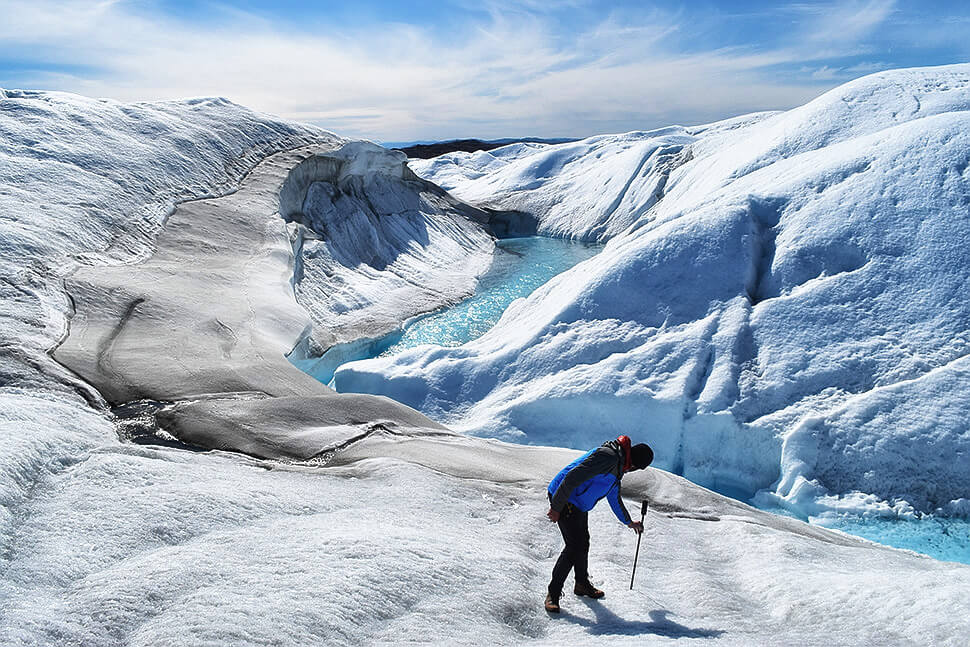Under the influence of global warming, the Greenland ice sheet area, washed by rains in the summer and now in the winter seasons, is becoming more significant. This leads to its rapid melting, which has already begun to make its way into the interior of the island, and if the situation does not change in the near future, the phenomenon will continue to spread, accelerating the pace of rising sea levels.
Between 1979 and 2012, the volume of ice melted by the rains and the effects they created doubled in summer and tripled in winter. At the same time, the total amount of precipitation over the cover has not changed, only their form has changed – now it is raining instead of snow.
-Marilena Oltmann, lead author of the study from the Center. Helmholtz Ocean Research (GEOMAR, Germany)
In recent decades, Greenland is increasing the rate of ice loss due to progressive warming. Since about 1990, the average temperature above the ice sheet has increased by 1.8 degrees in the summer and by 3 degrees in the winter. At present, it has been established that an area of more than 1.6 million square kilometers annually loses about 270 billion tons of ice. The greatest contribution to this process, as previously thought, is made by icebergs leaving the ocean. Recently, however, scientists are inclined to believe that direct meltwater accounts for about 70 percent of losses, and rainy weather, according to the authors of the study, is increasingly becoming the cause of their formation.
To find out, Marilena Oltmann and her team combined satellite images with records of meteoric stations for 34 years. The satellite data was used to display the situation in real time, as they can distinguish snow from liquid water, and about 20 automated weather stations scattered across the ice sheet provided parallel information about temperature, wind and precipitation. By combining two sets of data, the researchers identified more than 300 events in which rains caused melting.
The loss of ice can be caused by a complex of factors, but liquid water is one of the most powerful. An increase in temperature has many implications for this process, in particular, atmospheric conditions reach a point where rain begins to fall instead of snow. Liquid water carries a lot of heat, and when it is absorbed into the snow surface, it melts the snow around. In addition, the warm air often forms clouds that add problems.
-Marco Tedesco, co-author of the study from Columbia University (USA)
In addition to the short-term effects of rain, there are more long-term. For example, after the fallout, some of the melt water goes into the ocean, and the rest remains in place, turning white fluffy snow, which reflects the light well, into darker, denser masses of ice, which absorbs solar radiation better and melts faster. This leads to a chain reaction, covering all large areas.
If it rains in winter, then in summer the ice becomes more vulnerable.
-Marco Tedesco
If the average air temperature continues to grow, the line where precipitation falls as rain will quickly move from the southern part of Greenland into the interior of the island and into the northern part, while the ice cover is untouched by water, which should gain mass in winter when it snows, will become vulnerable.
Greenland is not the only place in the far north that has suffered from increasing rains. In recent years, anomalous winter rains fell on the Canadian tundra, where the water, freezing, sealed the plants that feed the caribou and musk ox, pulling them through the loose snow. This led to the death of entire herds. In Alaska, this effect is even more global: spring rains penetrate the permafrost, which thaws, emitting large amounts of methane – a highly efficient greenhouse gas.
Between 1993 and 2014, the rate of sea level rise increased from 2.2 millimeters to 3.3 millimeters per year, and scientists believe that the main contribution to this process was the melting of glaciers in Greenland. Forecasts of sea level rise at the end of the 21st century range from 60 centimeters to 1.2 meters, but they do not take into account all the factors and what can actually happen to them with ice in Greenland, or with a much larger mass in the Antarctic.
The overall picture is clear, because of global warming, ice is melting. However, we need to identify specific processes that are responsible for this. They must be understood and included in the model. The new study makes an important step in this direction.
-Richard Alley, a glaciologist from the University of Pennsylvania (USA) who did not participate in the study
Rains erode the Greenland ice sheet. Why is this dangerous?
Click To Tweet
The post Rains erode the Greenland ice sheet. Why is this dangerous? appeared first on Upcosmos.com.
